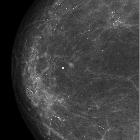Mastitis







Mastitis (rare plural: mastitides) refers to inflammation of the breast parenchyma, of which there are a number of subtypes:
- acute mastitis
- puerperal mastitis: occurs usually from infection with Staphylococcus spp. during lactation
- non-puerperal mastitis: not related to lactation, and occurs usually in older women
- plasma cell mastitis (mammary duct ectasia): uncommon subareolar inflammation without associated bacterial infection
- granulomatous mastitis: rare; usually occurs due to tuberculosis or sarcoidosis
Clinical presentation
Clinically, the breast will be indurated, red and painful. Nipple retraction may also be evident. Nodal enlargement is common. The patient may often have systemic symptoms such as fever or leukocytosis.
Complications
- breast abscess formation
Radiographic features
Mammography
On mammography, bacterial (puerperal or non-puerperal) mastitis will usually feature ill-defined regions of increased density and skin thickening.
Ultrasound
On ultrasound, ill-defined area of altered echotexture with hyperechogenicity representing infiltrated and inflamed fat lobules, hypoechoic areas in the glandular parenchyma, and associated mild skin thickening are seen. Inflammatory axillary lymph nodes may also be encountered. Occasionally abscess formation may be visible.
Differential diagnosis
It is important to consider inflammatory breast cancer as a potential differential.
Siehe auch:
- chronische abakterielle Mastitis
- inflammatorisches Mammakarzinom
- idiopathische granulomatöse Mastitis
- granulomatöse Mastitiden allgemein
- Systemischer Lupus Erythematodes (Manifestationen in der Mamma)
- Mastitis des Neugeborenen
und weiter:

 Assoziationen und Differentialdiagnosen zu Mastitis:
Assoziationen und Differentialdiagnosen zu Mastitis:



